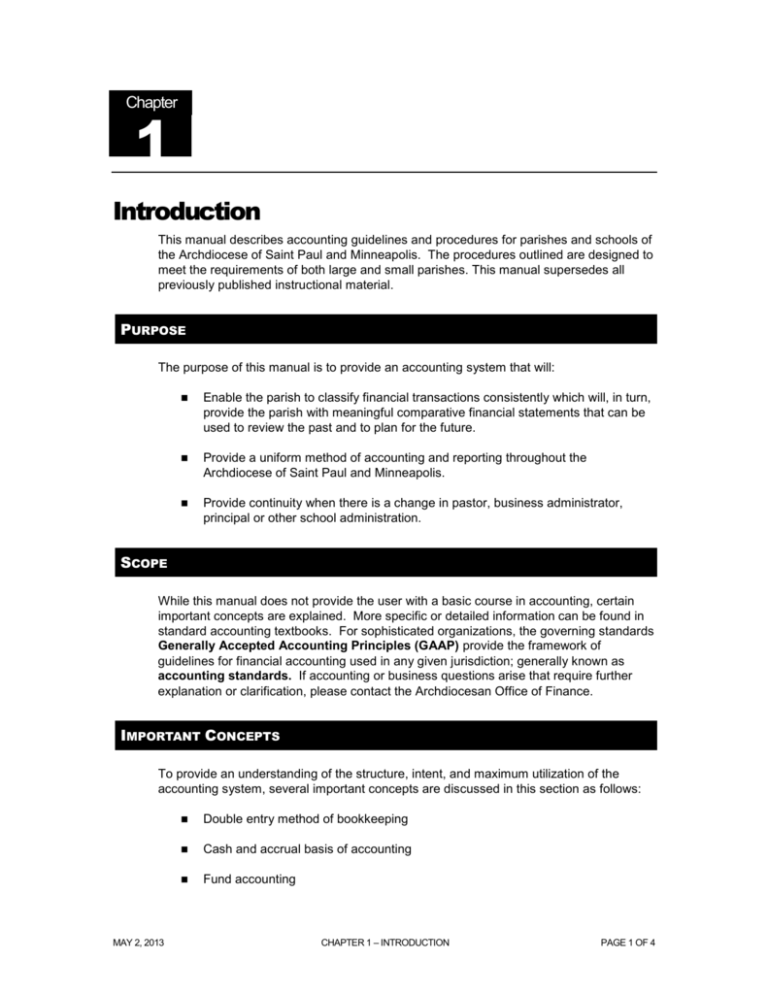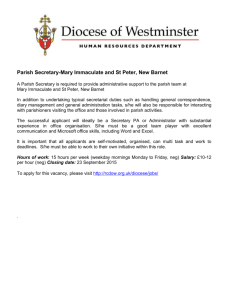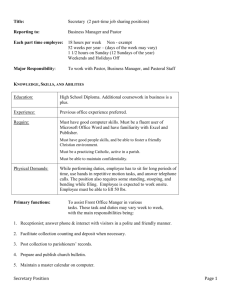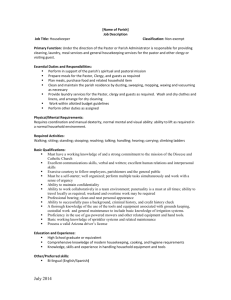Introduction - Archdiocese of Saint Paul and Minneapolis
advertisement

Chapter 1 Introduction This manual describes accounting guidelines and procedures for parishes and schools of the Archdiocese of Saint Paul and Minneapolis. The procedures outlined are designed to meet the requirements of both large and small parishes. This manual supersedes all previously published instructional material. PURPOSE The purpose of this manual is to provide an accounting system that will: Enable the parish to classify financial transactions consistently which will, in turn, provide the parish with meaningful comparative financial statements that can be used to review the past and to plan for the future. Provide a uniform method of accounting and reporting throughout the Archdiocese of Saint Paul and Minneapolis. Provide continuity when there is a change in pastor, business administrator, principal or other school administration. SCOPE While this manual does not provide the user with a basic course in accounting, certain important concepts are explained. More specific or detailed information can be found in standard accounting textbooks. For sophisticated organizations, the governing standards Generally Accepted Accounting Principles (GAAP) provide the framework of guidelines for financial accounting used in any given jurisdiction; generally known as accounting standards. If accounting or business questions arise that require further explanation or clarification, please contact the Archdiocesan Office of Finance. IMPORTANT CONCEPTS To provide an understanding of the structure, intent, and maximum utilization of the accounting system, several important concepts are discussed in this section as follows: MAY 2, 2013 Double entry method of bookkeeping Cash and accrual basis of accounting Fund accounting CHAPTER 1 – INTRODUCTION PAGE 1 OF 4 Double Entry Method of Bookkeeping The fundamental accounting equation applicable to any entity, from the smallest parish to the largest corporation is: Assets minus Liabilities equal Net Assets (or Equity) Another way to state the equation is: Assets equal Liabilities plus Net Assets This means that the total assets on the balance sheet should equal the total liabilities and net assets. Revenue over or under expenditures is included in net assets. Therefore, revenue and expenses are included in the equation. As the equation illustrates, all financial transactions have at least two effects. For example, a decrease in an asset, such as cash, may have one or more of the following effects: Increase another asset (investments) Decrease a liability (notes payable) Decrease net assets (payment of expense) Transactions are self-balancing, in that all effects are accounted for and are equal. Total debits and total credits in any journal entry must equal. The equation remains mathematically in balance. Each balanced entry is recorded in the cash receipts journal, cash disbursements journal, or balance sheet accounts and posted to the general ledger. The balanced general ledger thus represents a summary of the financial activities during the reporting period. This accounting method is commonly referred to as a double-entry system (developed in 1494 by Luca Pacioli, a Catholic monk). The elements of the accounting equation, as they relate to the parish, are defined as follows: Asset: any cash, cash equivalents and personal property. Liability: a debt or an amount owed to some person or organization, payable in the form of cash. A liability is a claim of outside parties on the assets of the parish. Net Assets: the residual equity (assets minus liabilities) of the organization, formerly known as Fund Balance. Generally, it is computed as follows: Net Assets at beginning of accounting period Add (+) revenues of current period Deduct (-) expenditures of current period Net Assets at end of accounting period MAY 2, 2013 CHAPTER 1 – INTRODUCTION $xxx $xxx ($xxx) $xxx PAGE 2 OF 4 Revenues and expenses are an integral part of each accounting period. The net effect of the two determines the operating results of the period. Revenues: the gross income of the parish or school derived from parish collections, contributions, investment income, sale of fixed assets, sale of merchandise, receipts from socials and benefits, tuition, etc. Revenues do not include money that will have to be repaid or receipts that have already been recorded as revenue (e.g., receipt of loan proceeds or collection of accounts receivable). It is important to note that revenues are classified by their source (the point from which they were obtained), not by their intended use. Expenditures: the payment of cash or the incurring of a liability for services rendered to the parish or school, or for goods received by the parish or school (e.g., salaries, fringe payroll costs, supplies, travel, utilities). Expenditures do not include payment of liabilities already recorded or the investment of cash. The following table explains the meaning of the terms debit and credit: Assets .............. Debit to increase and credit to decrease Liabilities ......... Credit to increase and debit to decrease Income ............. Credit to increase and debit to decrease Expense ........... Debit to increase and credit to decrease Net Assets ....... Credit to increase and debit to decrease Cash and Accrual Basis of Accounting There are two methods for recording transactions. One is the cash basis, the other the accrual basis. The following is a brief description of each basis of accounting. Cash Basis: Income is recognized when cash is received and expenses are recorded when payment is made. Since transactions are recorded with the actual cash payment, costs attributable to activities during the reporting period may not be recorded if the cash payment is made prior to the beginning of the period or subsequent thereto. Likewise, income may be recorded in a period before or after it is actually earned, in the accounting sense. Example: A parish is planning a fundraising dinner to be held in July. The parish fiscal year ends June 30. Under cash basis accounting, the purchase of supplies for the dinner made in June would be recorded as expenses when the bills were paid. Ticket sales made before June 30 would be recorded as income when the money was received. Accrual Basis: Income is recognized and expenses are recorded when the activity occurs or benefit accrues, that is, when goods are used, services are performed, or the entity gains a right to an asset, regardless of when the cash payment or receipt is made. Example: In the example above, the purchases made in June would be recorded as expenses in July (the next fiscal year), when the dinner is actually held. Likewise, any ticket sales made before June 30 would not be recognized in income until the dinner was held. MAY 2, 2013 CHAPTER 1 – INTRODUCTION PAGE 3 OF 4 For reporting consistency and analysis of parish data, the Archdiocese of Saint Paul and Minneapolis has adopted the accrual method for the parishes’ financial management and reporting. Fund Accounting A fund is a self-balancing set of accounts established to record the financial activities associated with a specific purpose or objective. Each fund includes assets, liabilities, and a fund balance. The funds most commonly used by not-for-profit organizations are the general fund, temporarily restricted fund and permanently restricted fund. The use of these funds is not mandatory, and all not-for-profits do not use the same funds. For simplicity and clarity in recording and reporting financial data, parishes in the Archdiocese of Saint Paul and Minneapolis should use a general fund and if applicable, a cemetery fund and capital fund only. FISCAL YEAR The fiscal year adopted by the Archdiocese of Saint Paul and Minneapolis is the year beginning July 1 and ending June 30. All transactions are recorded and reported for this annual period from July 1 to June 30. Each month-end represents a reporting period, at which time the accounting records should be reconciled, summarized for parish internal reporting purposes and closed. BUSINESS CONDUCT AND MANAGEMENT Each pastor and his delegate have a fiduciary responsibility to the parishioners of a parish to administer the receipt and disbursement of parish funds in a prudent manner. Funds should be solicited and collected to the extent necessary to support parish activities. Funds should be disbursed for valid expenditures incurred as part of these activities. Prudent management of monies requires the pastor to safeguard monies received, conserve the assets of the parish, and expend funds within parish means. These activities are to be conducted in a manner that minimizes the potential for waste, fraud, or abuse, but more important, in a manner that establishes accountability for financial transactions. It is essential that pastors and his delegate exercise good business sense in the financial affairs of the parish. A pastor must be aware of accepted business practices and laws related to business dealings, such as requirements to file tax and other legal forms. When a pastor or his delegate is in doubt about the accepted business practice or legal ramifications of a given situation, he should seek the advice of the Parish Finance Council (see Chapter 2) and contact the Archdiocesan Office of Finance. Following these business and financial practices with the matters discussed in this manual will reduce the exposure to liability for the parish or school. MAY 2, 2013 CHAPTER 1 – INTRODUCTION PAGE 4 OF 4







